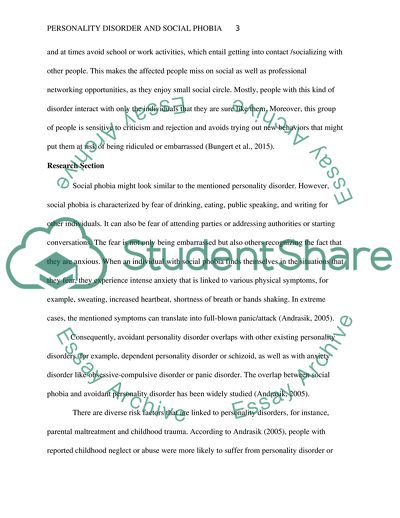Cite this document
(Personality Disorder and Social Phobia - Common Traits Research Paper Example | Topics and Well Written Essays - 1250 words, n.d.)
Personality Disorder and Social Phobia - Common Traits Research Paper Example | Topics and Well Written Essays - 1250 words. https://studentshare.org/psychology/1876569-the-differences-and-similarities-between-personality-disorder-and-social-phobia-narrow-it-with-chilhood-neglect-show-how-much-negative-childhood-neglect-contribute-in-the-etiology-of-these-disease
Personality Disorder and Social Phobia - Common Traits Research Paper Example | Topics and Well Written Essays - 1250 words. https://studentshare.org/psychology/1876569-the-differences-and-similarities-between-personality-disorder-and-social-phobia-narrow-it-with-chilhood-neglect-show-how-much-negative-childhood-neglect-contribute-in-the-etiology-of-these-disease
(Personality Disorder and Social Phobia - Common Traits Research Paper Example | Topics and Well Written Essays - 1250 Words)
Personality Disorder and Social Phobia - Common Traits Research Paper Example | Topics and Well Written Essays - 1250 Words. https://studentshare.org/psychology/1876569-the-differences-and-similarities-between-personality-disorder-and-social-phobia-narrow-it-with-chilhood-neglect-show-how-much-negative-childhood-neglect-contribute-in-the-etiology-of-these-disease.
Personality Disorder and Social Phobia - Common Traits Research Paper Example | Topics and Well Written Essays - 1250 Words. https://studentshare.org/psychology/1876569-the-differences-and-similarities-between-personality-disorder-and-social-phobia-narrow-it-with-chilhood-neglect-show-how-much-negative-childhood-neglect-contribute-in-the-etiology-of-these-disease.
“Personality Disorder and Social Phobia - Common Traits Research Paper Example | Topics and Well Written Essays - 1250 Words”. https://studentshare.org/psychology/1876569-the-differences-and-similarities-between-personality-disorder-and-social-phobia-narrow-it-with-chilhood-neglect-show-how-much-negative-childhood-neglect-contribute-in-the-etiology-of-these-disease.


